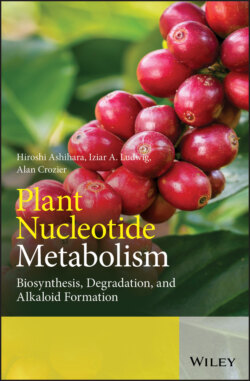Читать книгу Plant Nucleotide Metabolism - Hiroshi Ashihara - Страница 70
5.3.1 Adenine Phosphoribosyltransferase
ОглавлениеAdenine phosphoribosyltransferase (APRT) (EC 2.4.2.7) catalyses the formation of AMP from adenine and PRPP (reaction 1 in Figure 5.1). APRT, and PRPP, the substrate of this enzyme, was first isolated from yeast by Arthur Kornberg, the American Nobel Prize Laureate, and subsequently APRT was found in bacteria, animals and plants (Kornberg et al. 1955a,b).
Kinetic properties of the native and recombinant APRT and HGPRT with the Arabidopsis Information Resource (TAIR) locus of the genes encoding these phosphoribosyltransferases in A. thaliana are listed in Table 5.2. Studies on APRT from several plants indicate high affinity with adenine; the Km values are usually low (1–10 μM). In contrast, the Km values for PRPP can fluctuate between 1 and 300 μM. APRT activity is inhibited by AMP, but no significant effect has been observed with other nucleotides (Hirose and Ashihara 1983).
The Arabidopsis genome has five APRT sequences (Table 5.2), three of which, APT1, APT2, and APT3, have been cloned, overexpressed, and their catalytic properties characterized (Moffatt et al. 1992). All three isozymes bind adenine (Km: <3 μM). One of the isoenzymes (APT1) is 40–80 times more efficient, judged by the Vmax/Km ratio, in metabolizing adenine than the other isozymes. Since none of the predicted amino acid sequences for the adenine phosphoribosyltransferases (APTs) of A. thaliana appear to contain transit signalling peptides, APTs are assumed to be located in the cytosol. However, the findings of Zybailov et al. (2008) suggest that an isoform of APT1 has a transit peptide for chloroplasts. Traditional biochemical analysis indicates that in addition to the cytosol, APRT also occurs in plastids and mitochondria in some plants, (see Ashihara et al. 2018). Biochemical analysis indicates that large quantities of APRT activity are located in cytosol, but substantial amounts are also found in chloroplasts of spinach (Ashihara and Ukaji 1985) and tea leaves (Koshiishi et al. 2001), as well as mitochondria of Catharanthus roseus cells (Hirose and Ashihara 1982) and tubers of Jerusalem artichoke (Helianthus tuberosus) (Le Floc'h and Lafleuriel 1983). Although the occurrence of APRT in mitochondria has not yet been confirmed at the molecular level, purified intact mitochondria from C. roseus are capable of synthesizing adenine nucleotides from 14C-labelled adenine (Ukaji et al. 1986).
